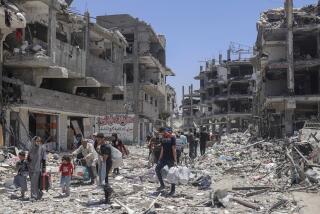Mexican Government Proposal Angers Rebels : Chiapas: But Zapatista delegates agree to take plan to their supporters and continue negotiations next month.
- Share via
SAN ANDRES LARRAINZAR, Mexico — Rebel negotiators reacted angrily Sunday to a government proposal that easing of tensions in the troubled southern state of Chiapas consist of gathering armed guerrillas into three camps. But they agreed to present the idea to their supporters.
The government plan contrasted sharply with a detailed, 20-point rebel proposal.
“We feel that the government delegates want to talk not about peace, but about surrender,” Commander Tacho, coordinator of the ski-masked rebel delegation, told reporters. “They have not taken into account that our demilitarization proposals are reciprocal and balanced, and they are making fun of them, saying that our proposals are publicity stunts.”
Nevertheless, the eight rebel delegates agreed to present the government proposal to their supporters and to return May 12 to continue the negotiations, which also include setting an agenda for further talks.
The question of military deployment is the toughest issue being tackled in this round of negotiations between the government and the Zapatista National Liberation Army. At stake is the fate of thousands of refugees now living in the hills, where they ran when the Mexican army entered the former guerrilla territory in February.
To solve the problem, the government proposed that rebel troops retire to three areas where they would be given food and shelter as a step toward turning the Zapatistas into a legal political force. The proposal stated that the government has already taken various steps toward a return to normalcy, including pulling troops to the outskirts of former rebel villages.
The Zapatistas proposed that the Mexican army withdraw from an area about half the size of Delaware that it has occupied since February; in exchange, armed rebels would not return to area villages.
Besides the withdrawal of troops from the area, the Zapatistas proposed that both sides agree to allow free transit through the zone; to accept oversight by both the government’s National Human Rights Commission and the negotiation mediating committee; to conduct no military operations, and to encourage Zapatistas and pacifists living in the area to treat each other with respect.
An agreement could be a significant step toward finding a way for both Zapatista supporters and their neighbors who refused to take up arms to feel secure.
The most immediate concern is the thousands of Zapatista supporters--in some cases entire villages--who have been camped out in the hills since the Mexican army took control of the area the rebels had held for 13 months.
They are the third wave of refugees caused by the conflict, even though there has been virtually no fighting since January, 1994. The first two waves--one when the conflict began and a second in September--were made up of pacifists who share many of the Zapatistas’ goals of democracy and better living conditions but oppose taking up arms as a way to achieve those ends. They fled rebel rule, living for months in refugee camps in towns on the perimeter of what was Zapatista territory.
They returned with the federal troops to towns such as Maravillas, where 430 townspeople say they were driven out in September by 80 rebels with machetes.
“We want the army to stay here permanently,” Pedro Santis, one of the returning villagers, said in a recent interview. But his 42 Zapatista neighbors are hiding in the hills, afraid of the troops camped just outside their village.
Similarly, no one has returned to the former rebel strongholds of La Garucha and Guadalupe Tepeyac, where rebel supporters apparently are afraid of Mexican army troops.
“Our people will just have to stay in the mountains,” Tacho said.
More to Read
Sign up for Essential California
The most important California stories and recommendations in your inbox every morning.
You may occasionally receive promotional content from the Los Angeles Times.










